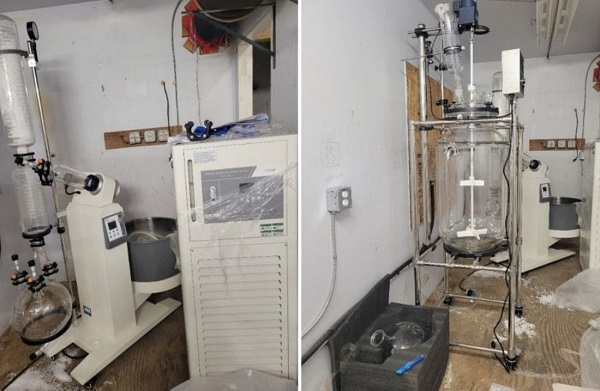Business
Bank of Canada missteps helped fuel today’s inflation

From the Fraser Institute
By Herbert Grubel and John Greenwood
The correlation between the quantity of money and inflation shown is not perfect but strong enough to justify the conclusion that Canada would have avoided the inflation starting in early 2021 had the Bank not increased the money supply so dramatically during the first year of the pandemic.
According to Statistics Canada’s latest consumer price index report, in February the annual inflation rate fell to 2.8 per cent, raising the prospect of interest rate cuts by the Bank of Canada sometime this year. “Inflation is caused by too many dollars chasing too few goods” used to be the traditional diagnosis of the cause of inflation, prompting central banks to fight it by slowing the growth of the money supply. This approach is based on what is known as the “monetarist” theory of inflation, which suggests that supply shocks such as those associated with the COVID pandemic do not cause inflation but only a temporary increase in the price level, which is reversed once the cause of the shock ends—unless the money supply has increased.
In recent decades, central banks have fought inflation using interest rates instead of monetary growth. This switch followed the postwar success of Keynesian theory, which blames inflation on excess aggregate demand, which higher interest rates are supposed to curtail.
Targeting interest rates can work if central banks simultaneously pay attention to money growth, but too often they’ve failed to do so. Equally, targeting the money supply can create inflation-fighting interest rates. However, interest rate targeting in practice has a serious shortcoming. Aggregate spending is influenced by real interest rates while central banks can set only nominal rates and real rates are beyond their control because they cannot change inflation by any direct policy.
This important problem arises because, for example, a nominal interest rate of 6 per cent turns into a real rate of minus 2 per cent if the expected inflation is 8 per cent. At that rate, investors can borrow $1 million at 6 per cent, use the money to buy real estate, sell it a year later after it has appreciated at the expected 8 per cent, repay the $1 million and take home a capital gain of $20,000. In other words, the high expected inflation rate incentivizes consumers and businesses to borrow more, which results in faster money growth and risks even higher inflation.
The expected rate of inflation exists only in peoples’ minds and is determined by many factors. The Bank of Canada collects as much information as it can, drawing on the results of public surveys, the information contained in the prices of so-called Real Return Yields, and sophisticated economic models produced by the Bank’s economists. But these efforts do not result in reliable information, as evidenced by the uncertain and speculative nature of economic forecasts found in its economic updates.
The problems associated with not knowing the real rate of interest have persuaded some economists, called “monetarists,” to urge central banks to target the money supply including famed economist Milton Friedman whose monumental study of the history of U.S. money supply and inflation inspired many including David Laidler, emeritus professor at the University of Western Ontario, and Britain’s John Greenwood who maintains a large database he used to create the accompanying graph.
This graph shows Canada’s annual rate of inflation (measured on the left axis) and the annual rate of growth of the money supply (M3) (measured on the right axis) for the years 2014 to 2024 using data published by the Bank of Canada and Statistics Canada, which require little manipulation. The annual percentage change in the money supply is averaged over 12-months, as is done widely to smooth data that fluctuate much over short periods; and the resultant time series is shifted forward 18 months, to achieve the best fit between changes in money growth and changes in inflation in the monetarist tradition, which has found the lag to have been variable historically between 12 and 18 months. (Thus, the peak smoothed money supply growth rate of more than 13 per cent occurred in February/March 2021, but is shown as occurring in August/September 2022, some 18 months later and close to the peak of inflation in June 2022.)
The correlation between the quantity of money and inflation shown is not perfect but strong enough to justify the conclusion that Canada would have avoided the inflation starting in early 2021 had the Bank not increased the money supply so dramatically during the first year of the pandemic.
In 1994, John Crow, then-governor of the Bank of Canada, presented to a parliamentary finance committee a report on the economic outlook. One of the authors of this op-ed (Grubel) was at this meeting. In response to his question, Crow said that the Bank’s econometric forecasting model did not include data on the money supply but that he always looked over his shoulders to ensure it does not get out of line. If his successors had followed his practice, perhaps Canada’s present inflation would have been avoided.
But then it would not be possible to test the usefulness of the model, which draws on money supply growth data over the last 18 months to predict that inflation should fall to 2 per cent near year-end 2024 or early 2025.
If the prediction is realized, however, Canadians should not expect the lower inflation rate to result in lower costs of living. That would happen only if the Bank made the money growth rate negative, something history suggests is unlikely because it usually resulted in recessions. How much better it would have been if the inflation genie had never been allowed out of the lamp.
Authors:
Internet
US government gave $22 million to nonprofit teaching teens about sex toys: report

From LifeSiteNews
The Center for Innovative Public Health Research’s website suggests teenage girls make their ‘own decisions’ about sex and not let their parents know if they don’t want to.
For almost a decade, the U.S. government funded a group that actively works to teach kids how to use sex toys and then keep them hidden from their parents to the tune of $22 million.
According to investigative reporter Hannah Grossman at the Manhattan Institute, The Center for Innovative Public Health Research (CIPHR) has been educating minors about sex toys with public funds.
Records show that the millions given to the group since 2016, according to its website, go toward “health education programs” that “promote positive human development.”
However, the actual contents of the programs, as can be seen from comments from CIPHR CEO Michele Ybarra, seem to suggest that its idea of “human” development is skewed toward radical sex education doctrine.
In 2017, CIPHR launched Girl2Girl, which is funded by federal money to promote “sex-ed program just for teen girls who are into girls.” Its website lets users, who are girls between ages 14 and 16, sign up for “daily text messages … about things like sex with girls and boys.”
The actual content of some of the messages is very concerning. Its website notes that some of the texts talk about “lube and sex toys” as well as “the different types of sex and ways to increase pleasure.”
The website actively calls upon teenage girls to make their “own decisions” and not let their parents know if they don’t want to.
Grossman shared a video clip on X of Ybarra explaining how they educate minors about the use of “sex toys” and dealing with their parents if they are found out.
The clip, from a 2022 Brown University webinar, shows Ybarra telling researchers how to prepare “young person(s)” for her research.
She said if they are doing “focus groups,” she will ask them, “Okay, so what happens if somebody comes into the room and sees words like penis and sex toys on your screen — on your computer screen or on your phone? What if it’s your mom?’”
In 2023, CIPHR launched Transcendent Health, which is a sex-education program for minors who are gender confused. This initiative received $1.3 million of federal grant money that expired last month.
Grossman observed that the federal government “should not fund programs that send sexually explicit messages to minors and encourage them to conceal these communications from parents.”
She noted that in order to protect children and “prevent further harm,” U.S. President Donald Trump’s Department of Health and Human Services “should immediately cancel CIPHR’s active contract and deny its future grant applications.”
“By doing so, the Trump administration can send a clear message: Taxpayers will no longer foot the bill for perverted ‘research’ projects,” she noted.
The Trump administration has thus far, through the Department of Government Efficiency (DOGE), exposed billions in government waste and fraud. Many such uses of taxpayer dollars are currently under review by the administration, including pro-abortion and pro-censorship activity through USAID, “Diversity, Equity, and Inclusion and neo-Marxist class warfare propaganda” through the National Science Foundation, and billions to left-wing “green energy” nonprofits through the Environmental Protection Agency.
Business
Canadian Police Raid Sophisticated Vancouver Fentanyl Labs, But Insist Millions of Pills Not Destined for U.S.

 Sam Cooper
Sam Cooper
Mounties say labs outfitted with high-grade chemistry equipment and a trained chemist reveal transnational crime groups are advancing in technical sophistication and drug production capacity
Amid a growing trade war between Washington and Beijing, Canada—targeted alongside Mexico and China for special tariffs related to Chinese fentanyl supply chains—has dismantled a sophisticated network of fentanyl labs across British Columbia and arrested an academic lab chemist, the RCMP said Thursday.
At a press conference in Vancouver, senior investigators stood behind seized lab equipment and fentanyl supplies, telling reporters the operation had prevented millions of potentially lethal pills from reaching the streets.
“This interdiction has prevented several million potentially lethal doses of fentanyl from being produced and distributed across Canada,” said Cpl. Arash Seyed. But the presence of commercial-grade laboratory equipment at each of the sites—paired with the arrest of a suspect believed to have formal training in chemistry—signals an evolution in the capabilities of organized crime networks, with “progressively enhanced scientific and technical expertise among transnational organized crime groups involved in the production and distribution of illicit drugs,” Seyed added.
This investigation is ongoing, while the seized drugs, precursor chemicals, and other evidence continue to be processed, police said.
Recent Canadian data confirms the country has become an exporter of fentanyl, and experts identify British Columbia as the epicenter of clandestine labs supplied by Chinese precursors and linked to Mexican cartel distributors upstream.
In a statement that appears politically responsive to the evolving Trump trade threats, Assistant Commissioner David Teboul said, “There continues to be no evidence, in this case and others, that these labs are producing fentanyl for exportation into the United States.”
In late March, during coordinated raids across the suburban municipalities of Pitt Meadows, Mission, Aldergrove, Langley, and Richmond, investigators took down three clandestine fentanyl production sites.
The labs were described by the RCMP as “equipped with specialized chemical processing equipment often found in academic and professional research facilities.” Photos released by authorities show stainless steel reaction vessels, industrial filters, and what appear to be commercial-scale tablet presses and drying trays—pointing to mass production capabilities.
The takedown comes as Canada finds itself in the crosshairs of intensifying geopolitical tension.
Fentanyl remains the leading cause of drug-related deaths in Canada, with toxic supply chains increasingly linked to hybrid transnational networks involving Chinese chemical brokers and domestic Canadian producers.
RCMP said the sprawling B.C. lab probe was launched in the summer of 2023, with teams initiating an investigation into the importation of unregulated chemicals and commercial laboratory equipment that could be used for synthesizing illicit drugs including fentanyl, MDMA, and GHB.
The Bureau is a reader-supported publication.
To receive new posts and support my work, consider becoming a free or paid subscriber.
Invite your friends and earn rewards
-

 Also Interesting2 days ago
Also Interesting2 days agoMortgage Mayhem: How Rising Interest Rates Are Squeezing Alberta Homeowners
-

 2025 Federal Election2 days ago
2025 Federal Election2 days agoConservative Party urges investigation into Carney plan to spend $1 billion on heat pumps
-

 Also Interesting2 days ago
Also Interesting2 days agoExploring Wildrobin Technological Advancements in Live Dealer Games
-

 2025 Federal Election2 days ago
2025 Federal Election2 days agoCommunist China helped boost Mark Carney’s image on social media, election watchdog reports
-

 2025 Federal Election2 days ago
2025 Federal Election2 days agoFifty Shades of Mark Carney
-

 2025 Federal Election2 days ago
2025 Federal Election2 days agoCorporate Media Isn’t Reporting on Foreign Interference—It’s Covering for It
-

 Justice2 days ago
Justice2 days agoCanadian government sued for forcing women to share spaces with ‘transgender’ male prisoners
-

 Business1 day ago
Business1 day agoStocks soar after Trump suspends tariffs





